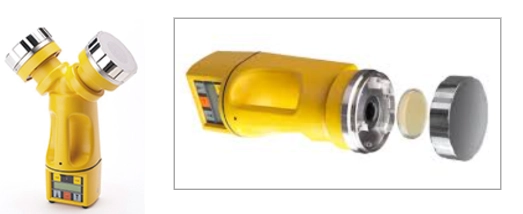Environmental microbiological control of air (volumetric)
Code: 60002, 60004
Type: Control de qualitat de medicaments de teràpia avançada
Technical information
Utility
Clean rooms or white rooms are specially designed to ensure low levels of contamination and have environmental parameters strictly controlled by regulations. Environmental microbiological controls allow to know the microbiological conditions of the facilities, equipment, and operators, in order to ensure compliance with regulations.
The most common origin of microorganisms found in a facility is:
-
The personnel entering the facility.
-
The material entering the facility.
-
The air filtration system (HEPA filters in clean rooms).
The elements that can become contaminated with microorganisms and pose a risk are:
-
Air: Ambient air or laminar flow hoods
-
Surfaces: Floor, walls, tables, handles, etc.
-
Equipment: Incubators, laminar flow hoods, centrifuges, refrigerators, microscopes, balances, etc.
-
Clothing: Gloves, operator's clothing.
The definition of environmental control points and frequencies is based on an analysis of environmental risk conducted before the start of activities in a facility, and it reviews the rooms, equipment, materials, work flows, the number of people working there, and other factors.
Method
The plates used for environmental microbiological control are shown in Table 1. The plates contain the appropriate culture media for the growth of bacteria and fungi. They also include agents that neutralize the possible presence of disinfectants to prevent them from interfering with the growth of microorganisms.
Before using a batch of plates, a growth promotion test is performed, which serves to verify if that batch of plates allows the growth of microorganisms.
|
Medium |
Technique |
Element to control |
Microorganisms |
|
TSA contact with neutralizing agents 55 mm plate |
Contact |
Surfaces |
Bacteria |
|
SDA contact with neutralizing agents 55 mm plate |
Fungi |
||
|
TSA with neutralizing agents 90 mm plate |
Volumetric air |
Air |
Bacteria |
|
SDA with neutralizing agents 90 mm plate |
Fungi |
||
|
TSA with neutralizing agents 90 mm plate |
Sedimentation air |
Air |
Bacteria |
|
SDA with neutralizing agents 90 mm plate |
Fungi |
||
|
TSA with neutralizing agents 90 mm plate |
Fingerprint |
Gloves |
Bacteria |
|
SDA with neutralizing agents 90 mm plate |
Fungi |
Table 1. TSA: Tryptone Soya Agar medium. SDA: Sabouraud Dextrose Agar medium
The most suitable environmental microbiological control techniques for the points to be monitored are shown in Table 2:
|
Element |
Technique |
|
Air |
Volumetric or sedimentation air sampling |
|
Surfaces |
Contact |
|
Operator |
Glove impression |
Table 2: Techniques used to sample different elements.
The volumetric air sampling technique requires a sampling device like the one shown in Figure 1. This device aspirates the programmed amount of ambient air and passes it through a lid with holes to the culture plate.

Figure 1: Air sampler
It is very important to follow the manufacturer's instructions and program the equipment to sample 1 m3 of air. Hands and equipment must be properly disinfected before use to avoid false positives. It is crucial to place and remove the plate without contaminating it and to cover it immediately after sampling. Sampling must be done twice: once with a plate for fungi and once with a plate for bacteria.
The plates must be sent to the Microbiology Laboratory as soon as possible after sampling. They are received and incubated there:
-
TSA plates are incubated at 32.5°C (30-35°C) for 3-5 days for bacteria
-
SDA plates are incubated at 22.5°C (
Specimen information
Sample: Air (volumetric)
Tubes: 90 mm TSA Plate (bacteria) and 90 mm SDA Plate (fungi)
Stability: Transport immediately to the laboratory. If not possible, store at room temperature for a maximum of 4 hours.
Transport instructions: Room temperature.
Reasons for rejection: Plate not closed properly, not identified, etc.
Administrative information
BST Code: 60002 (bacteria) and 60004 (fungi)
Old BST Code: 7536 (bacteria) and 7551 (fungi)
Test Description: Air bacterial control (volumetric) and Air fungi control (volumetric)
Synonyms: Volumetric air CMA, Environmental air microbiological control (volumetric)
Section: Microbiology
BST Fee: Check the updated fees here.
Profiles
Not applicable
References
-
Guide to the quality and safety of tissues and cells for human application. 5th edition EDQM, 2022
-
Farmacopea Europea 11ena edició, 2023
-
ISO 171330-1:2008 Calidad ambiental en interiores. Parte 1: Diagnóstico de calidad ambiental interior.
-
ISO 171330-2:2014 Calidad ambiental en interiores. Parte 2: Procedimientos de inspección de calidad ambiental interior.
-
ISO 171330-3:2014 Calidad ambiental en interiores. Parte 3: Sistema de gestión de los ambientes interiores.
-
ISO 171340:2020 Validación y cualificación de salas de ambiente controlado en hospitals
-
Norma EN ISO 14644-1. Clasificación de sala limpias.
-
Estándares en hemoteràpia CAT
-
FACT-JACIE International Standards for Cellular Therapy Product Collection, Processing, and Administration.
-
NETCORD-FACT International Standards for Cord Blood Collection, Banking, and Release for Administration.
-
NCF: Guía de Normas de Correcta Fabricación de Medicamentos de Uso Humano y Veterinario. Anexo 1
-
NCF Parte IV: Directrices sobre normas de correcta fabricación específicas para Medicamentos de Terapia Avanzada.
-
GpG. Directrices de Buenas Prácticas - Guía para la preparación, uso y control de calidad de los componentes sanguíneos.
-
Real Decreto-ley 9/2014, de 4 de julio, por el que se establecen las normas de calidad y seguridad para la donación, la obtención, la evaluación, el procesamiento, la preservación, el almacenamiento y la distribución de células y tejidos humanos y se aprueban las normas de coordinación y funcionamiento para su uso en humanos.